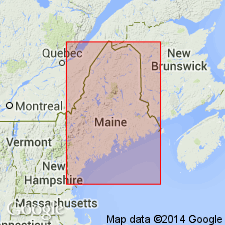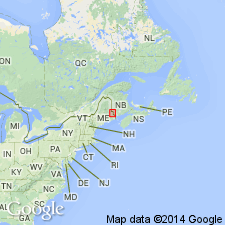
- Usage in publication:
-
- Bowers Mountain Formation
- Modifications:
-
- First used
- Dominant lithology:
-
- Slate
- Volcanics
- AAPG geologic province:
-
- New England province
Summary:
The Kossuth Group [new name] is subdivided in this report into (ascending) Bowers Mountain and Stetson Mountain Formations [new names.] Bowers Mountain is divided into four informal, unnamed members, but author states that he is uncertain whether these rocks actually belong within a single formation. Lowermost member on both the east and west flanks of the Miramichi terrane described as anoxic pelitic and arenaceous. This member is overlain on the east flank by volcanic rocks (basaltic tuff and massive basalt), and on the west flank, by sulfidic pelites intercalated with quartzose sandstone, and gray slates and siltstones. Age of the Bowers Mountain is poorly constrained. Cambrian(?) and Ordovician assignment based on its correlation with the Shin Brook Formation and on its position above the Baskahegan Lake Formation (new name), which is correlated with the Grand Pitch Formation.
Source: GNU records (USGS DDS-6; Reston GNULEX).

- Usage in publication:
-
- Bowers Mountain Formation
- Modifications:
-
- Overview
- AAPG geologic province:
-
- New England province
Summary:
"Rocks of the Miramichi belt are separated by an unconformity into two packages--the Baskahegan Lake Formation and the Kossuth Group." The Baskahegan Lake is more complexly deformed than the formations of the overlying Kossuth. A middle Caradocian age is indicated by graptolites for the Stetson Mountain Formation at the top of the Kossuth, while an Early Ordovician age (Arenigian(?)-Llandeilian) age is inferred for the lower part of the Bowers Mountain Formation. Coeval rocks in the St. Croix belt (Woodland Formation) appear lithologically similar, but their sequence is not the same. [Unit name is italicized throughout the report as authors consider it informal at this time. They state that it is being formally proposed but do not indicate a reference for such a proposal. Reader is referred to Ludman (1990), an Open-File report, for a complete description of the unit.]
Source: GNU records (USGS DDS-6; Reston GNULEX).
For more information, please contact Nancy Stamm, Geologic Names Committee Secretary.
Asterisk (*) indicates published by U.S. Geological Survey authors.
"No current usage" (†) implies that a name has been abandoned or has fallen into disuse. Former usage and, if known, replacement name given in parentheses ( ).
Slash (/) indicates name conflicts with nomenclatural guidelines (CSN, 1933; ACSN, 1961, 1970; NACSN, 1983, 2005, 2021). May be explained within brackets ([ ]).

